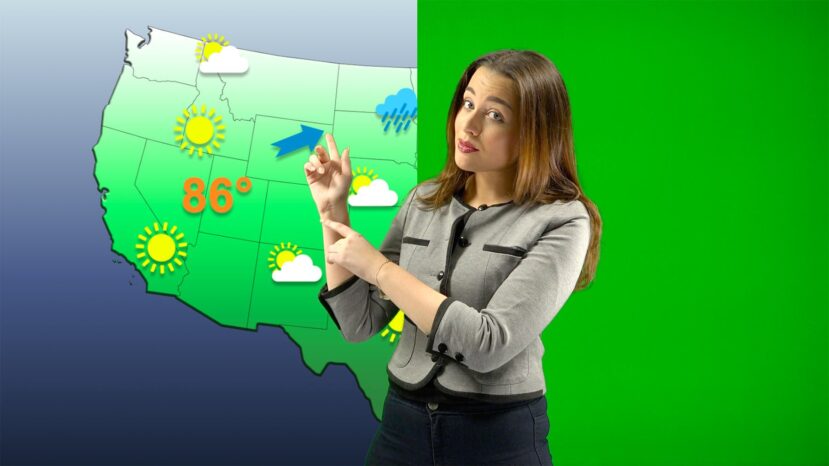Chroma Key or green screen technology
Chroma key is an effect that allows you to take a group of similar colors and render them transparent. It’s often used to isolate an object in a video, in movies to take a character and transport them to faraway lands, or on the TV news to tell you your local forecast for the next week in a more animated, visual way.

Setting Green Screen for weather forecast
In order to use the chroma key effectively, we need two things. We need a video or image that will serve as our background, in this case, our weather map, and we need a video of our subject, in this case, our weatherperson. We can make our background in Alight Motion, but for our weatherperson, we’ll need to film them in person. To do so, we need to make sure we film them in a way that will allow the chroma key to work well.
For filming our weatherperson, having a green screen large enough to fill the entire background behind them is ideal. If you don’t have a green screen, you can also use a wall, as long as it is fairly uniform in shape, a single, solid, bright color, and colored differently from the subject or anything they’re wearing. Green and blue are usually the best choices, as red/pink/brown/orange can be similar to skin tones, and white/grey/black doesn’t work well with the chroma key in general.
The right lighting for setting green screen
Once you have your location, it is important to light it uniformly behind your subject. Any shadows on your background may change the color significantly enough for it to not be recognized well in chroma key, leading to lower quality results. Multiple light sources are better than one, and if you have any way to diffuse the light, to make it softer, this will help to avoid any harsh shadows.
The weatherperson should be as far away as possible from the green screen, as light bouncing off of the green screen may cause green fringing around them, and they may cast a shadow on the screen. At this point, the weatherperson needs to be lit as well. Since we’re setting up for a weather forecast, we do not need any special lighting, but know that you may have to set up your lighting differently depending on the lighting in the shot you intend to use as your background, so you can match it as closely as possible.
A ring light can really help with this depending on your setup. They’re available for larger cameras as well as cell phones and will evenly light the subject’s face or body depending on the size.
Collect weather information
To obtain precise weather measurements, meteorologists from all over the world launch weather balloons, also known as radiosondes, twice every day at the same time. These balloons make their way through to the troposphere and measure air pressure, temperature, wind speed, and direction. This information is directly transmitted to a ground station and constitutes a snapshot of the weather at a particular point in time. Apart from radiosondes, the surface weather is also measured at observing stations all over the world, from buoys and ships at sea, and by weather radars.
These measurements are transmitted to weather prediction centers that are located in the United States, England, Canada, Australia, Germany, and many other countries across the world. All of these centers are equipped with supercomputers that model the raw data to generate a 3D grid that demonstrates the atmospheric changes. Future changes are computed in the 3D grid for the wind (both vertical and horizontal), temperature, cloud water, water vapor, and precipitation formation. The sophisticated models also include the effects of solar and infrared radiation on temperature. Together, all these equations are run as a program to generate a numerical weather forecast.
You can find more information on US weather sources here: https://weathersource.com
Continue Reading: Learn more about Green Screens


